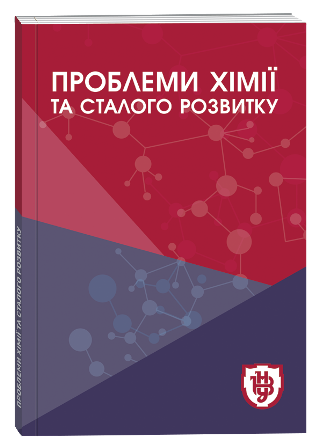THE CRYSTAL STRUCTURE OF Ce1.5Tb1.5Ga1.67S7
DOI:
https://doi.org/10.32782/pcsd-2022-4-3Keywords:
crystal structure, rare earth elements, X-ray powder method, EDAX analysisAbstract
The paper presents the results of the investigation of the crystal structure of Ce1.5Tb1.5Ga1.67S7 as a promising material, which is predicted to have interesting nonlinear optical properties. The synthesis of a sample of stoichiometric composition Ce1.5Tb1.5Ga1.67S7 with a total weight 0.8 g, was obtained by fusing simple substances in vacuumed quartz container to a residual pressure of 10 -2 Pa at a maximum synthesis temperature of 1100 °C. The crystal structure of Ce1.5Tb1.5Ga1.67S7 sulfide (a = 10.0316(4) Å, c = 6.0640(4) Å, V = 528.48(6) Å3, RI = 0.0498, Rp = 0.1553) was studied by the X-ray powder method. It was established that the structure of the synthesized sulfide belongs to the hexagonal symmetry (La3CuSiS7 structural type, SG P63; Pearson code hP24). The Ce1.5Tb1.5Ga1.67S7 is synthesized on the basis of La3Ga1.67S7 sulfide by replacement of lanthanum atoms in the site 6c by atoms of statistical mixture M (0.5 Ce + 0.5 Tb). The elemental composition of the Ce1.5Tb1.5Ga1.67S7 (Ce: 7.56 ± 1.34 %; Tb: 16.82 ± 3.18 %; Ga: 15.93 ± 1.44 %; S: 59.70 ± 3.07 %) was confirmed by EDAX analysis. In the structure of the investigated quaternary sulfide, atoms of the of statistical mixture M (0.5 Ce + 0.5 Tb) are localized in site 6c and, together with sulfur atoms, form trigonal prisms with one additional atom [M 3S13S21S3]. Trigonal prisms form “blocks” of 3[M 7S]. In these “blocks” trigonal prisms are connected to each other by ribs. The effective coordination number of atoms of the statistical mixture M (0.5 Ce + 0.5 Tb) is 6.84 due to the insignificant distortion index (calculated from bond lengths). The Ga1 (0.667) atoms, concentrated in site 2a, form octahedra [Ga1 6S1]. These octahedra are interconnected by faces and form columns in the direction of the c axis. The introduction of statistical mixture atoms into the structure of the La3Ga1.67S7 causes significant distortion of [Ga1 6S1] octahedra. In site 2b, Ga2 atoms are surrounded by four sulfur atoms [Ga2 3S21S3]. The insignificant distortion index (0.017 (calculated from the bond lengths)) of the tetrahedra indicates their high symmetry (the effective coordination number is 3.93).
References
Celania Ch., Mudring A.V. Structures, properties, and potential applications of rare earth-noble metal tellurides. J. Solid State Chem. 2019. 274. P. 243-258. doi:10.1016/j.jssc.2019.03.009
Shi X.L., Zou J., Chen Z.G. Advanced Thermoelectric Design: From Materials and Structures to Devices. Chem. Rev. 2020. 120(15). P. 7399-7515. doi:10.1021/acs.chemrev.0c00026
Tritt T. Thermal Conductivity. Physics of Solids and Liquids. 2005. 1(4). Р. 105-121. doi:10.1007/b136496
Kolobov A., Tominaga J. Chalcogenides: metastability and phase change phenomena. Springer Science & Business Media. 2012. 164. P. 284. doi:10.1007/978-3-642-44294-0
Si Q., Yu R., Abrahams E. High-temperature superconductivity in iron pnictides and chalcogenides. Nat. Rev. Mater. 2016. 1(4). Р. 1-10. doi:10.1038/natrevmats.2016.17
Spaldin N. Magnetic Materials: Fundamentals and Applications. Cambridge Univer. Press. 2010. 2. P. 14-21. doi:10.1017/CBO9780511781599
Eggleton B., Luther-Davies B., Richardson K. Chalcogenide photonics. Nat. Photon. 2011. 5(3). P. 1410-148. doi:10.1038/nphoton.2011.309
Ivashchenko I., Danyliuk I., Gulay L., Halyan V., Tishchenko P., Olekseyuk I. The quasi-ternary system La2S3 – Er2S3 – Ga2S3 and quaternary compounds of the composition La(Pr)1.5Tb(Y, Ho)1.5Ga1.67S7. Chem. Met. All. 2016. 9. P. 105-112. doi:10.30970/cma.9.0337
Смітюх О., Марчук О., Олексеюк І., Федорчук А. Кристалічна структура сполук Er1.5La(Pr)1.5Si1.67Se7. Наук. Вісн. Ужгород. у-ту. Сер. хімія. 2017. 1(37). C. 44-47.
Smitiukh O., Marchuk O., Fedorchuk A., Grebenyk A. Crystal structure of R3Si1.75Se7 (R ‒ 1.5Y + 1.5La). J. Alloys Compd. 2018. 765. P. 731-735. doi:10.1016/j.jallcom.2018.05.0.25
Мельничук Х., Смітюх О., Марчук О., Мазур Н., Юхимчук В. Структурні дослідження халькогенідів Ce0.5R1.5PbSi2S8 та Pr1.5R0.5PbSi2S8 (R ‒ Tb, Y, Er). Наук. Вісн. Ужгород. у-ту. Сер. хімія. 2020. 1(43). C. 6-15. doi:10.241444/2414-0260.2020.1.6-15
Guo S.P., Guo G.S., Wang M.S., Zou J.P., Xu G., Wang G.J., Huang J.S. A series of new infrared NLO and ferroelectric semiconductors, ZnY6Si2S14 and Al0.33-xLn3+xSiS7 (Ln ‒ Sm, Dy). Inorg. Chem. 2009. 48. P. 7059-7065. doi:10.1021/ic802443n
Poduska K., Disalvo F., Min K., Halasyamani P. Structure determination of La3CuGeS7 and La3CuGeSe7. J. Alloys Compd. 2002. 335. P. L5-L9. doi:10.1016/S0925-8388(01)01835-7
Daszkiewicz M., Gulay L. Pressure induced silver ion displacement La3Ag0.82SnS7. Mater. Res. Bull. 2012. 47. P. 497-499. doi:10.1016/j.materresbull.2011.11.033
Grin Y., Akselrud L. WinCSD: Software package for crystallographic calculations (Version 4). J. Appl. Cryst. 2014. 47(2). Р. 803-805. doi:10.1107/s1600576714001058
Momma K., Izumi F. VESTA 3 for three-dimensional visualization of crystal, volumetric and morphology data. J. Appl. Cryst. 2011. 44(6). Р. 1272-1276. doi:10.1107/S0021889811038970
Patrie M., Guittard M. Chimie minerale. Sur les composes du type Ce6Al10/3S14. C. R. Acad. Sci. 1969. 268. P. 1136-1138.
Guittard M., Julien-Pouzol M. Les composes hexagonaux de type La3CuSiS7. Bull. Soc. Chim. Fr. 1972. 3. P. 2207–2209.







